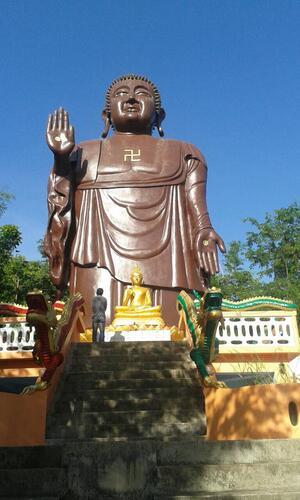Symbols
Have you ever explained the Holocaust to someone who's never heard of it before? I have.
I don't remember a time when the Holocaust wasn't a part of my consciousness. So imagine my surprise when, sitting with co-workers in a gazebo at our school, a girl of no more than 7 years old with a luminous smile ambled by, her shirt emblazoned with a massive swastika.
Now, many people who have studied or visited East Asia will tell you there is no shortage of swastikas here. They are graffiti-ed on buildings, tattooed on ankles, found in art and ancient temples. It's an auspicious symbol to many in this part of the world. But this shirt, I mean, it was literally the flag of Nazi Germany. Black, red, and white.
"Do you know what that symbol means?" I asked my Thai friends. They shook their heads. "Have you ever heard of Hitler?" Blank stares. "Nazis?" Crickets.
Their ignorance to something that is so monumentally offensive in the West would have been shocking to me a year ago. But after many months in this village, I’ve accidentally said and done many things with disregard for Thai beliefs and customs. I know that different words and actions carry different weights from culture to culture. Nevertheless, I felt the very presence of the symbol was an affront and I was shocked to be explaining the Holocaust to grown people.
At their behest, I provided my best explanation in Thai, which translated roughly to, “Many years ago, some people in Germany were afraid of people who were different and so they tried to kill as many as possible. The flag on her shirt was the symbol of their leader, Hitler, whose army killed more than 6 million people.”
Thai people are no strangers to the concept of genocide. In the 1970s, Thailand bore witness to the Khmer Rouge execution of more than 2 million people. However, common emotional triggers around the Holocaust for people with a Eurocentric worldview simply do not carry the same weight here. Thais have their own scars remaining from their own cultural and historical perils.
The image of the Nazi swastika is increasingly prevalent in popular culture here. I’ve seen swastika earrings framing the innocent faces of my 6th grade students, and hanging on the walls in Thai-owned western-style restaurants. I’ve seen Hitler’s face caricatured on t-shirts in the evening markets. This “Nazi chic” trend is the result of an uninformed public that repackages images found on the internet for popular consumption without regard for context.
Why does this happen? One answer could be the militarism that permeates Thai society from the moment children begin grade school (not to mention politics at the moment, Hello, Martial Law!). Uniforms, posture, behavior is all strictly regimented and scout activities are a daily occurrence. Perhaps they took interest in Nazi symbolism because on the surface they saw a powerful military movement?
Another possible answer is that the Thai core curriculum has some gaping holes that I’ve seen in action (explored here by the Global Times in August 2013). None of my students know what World War II is. That being said, only one student in my 7th grade class could locate Thailand on a world map. It’s scary to know that failing to educate ourselves and our communities about world history can and does lead these catastrophes to repeat and repeat and repeat themselves.
I am not the first westerner to be disturbed by casual displays of Nazi paraphernalia, but I don’t have the power to stop these images from being printed on t-shirts. How, then, can I create cultural understanding around this sensitive subject?
As the music god of my adolescence once wrote, “To change the world start with one step, however small.” The best I can do is share my perspective, and hope that it will be met with respect and, in time, understanding.









Those are Buddhist swastikas - not Nazi swastikas. The Nazi swastika is flipped 180 degrees, and then rotated 45 degrees. There's nothing of concern here.
*shudders* from my perspective as an American Jew, that's quite scary. Although I suppose when examined, it's not really as terrifying as it seems; ignorance and wearing a swastika is better than purposely wearing a swastika for anti-Semitic purposes.